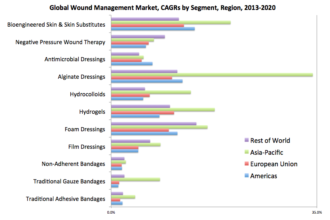Scott Hensley over at the NPR’s Shots blog posted a story about the recently approved molecular diagnostic test that can rapidly identify several gram-positive bacteria that cause blood stream infections. This is indeed important, since conventional microbiologic techniques rely on bacterial growth, which can take up to 2 to 3 days. This is too long to wait to identify the bug that is the cause of a serious infection.
Scott Hensley over at the NPR’s Shots blog posted a story about the recently approved molecular diagnostic test that can rapidly identify several gram-positive bacteria that cause blood stream infections. This is indeed important, since conventional microbiologic techniques rely on bacterial growth, which can take up to 2 to 3 days. This is too long to wait to identify the bug that is the cause of a serious infection. What doctors have done to date is make the best guess based on several factors, including the type of a patient, the source of the infection and the patterns of bacterial resistance at their site, to tailor empiric antibiotic coverage. The sicker the patient, the broader the coverage, until the culture results come back, when the doctor is meant to alter this treatment accordingly, either by narrowing or broadening the spectrum. The pitfalls of this work flow are obvious — too many points where error can enter the equation. So on the surface the new tests are a great advance. And they actually are, but they are not free of problems, and we need to be very explicit confronting them.
Each diagnostic test can be evaluated on its sensitivity (how well it identifies the problem when the problem exists), specificity (how rarely it identifies a problem when it does NOT exist), and positive (what proportion of all positive tests represents true problem) and negative (what proportion of all negative tests represents a true absence of problem). Sensitivity and specificity are intrinsic properties of the test and can be altered only by how the test is performed. Positive and negative predictive values are dependent not only on the test and how it is done, but also on the population that is getting tested.
Let’s take Nanosphere’s test in Scott’s story. If you troll the company’s web site, you will find that the sensitivity and specificity of this technology is close to 100%, if not 100%, the “gold standard” for comparison being conventional microbiology culture. And perhaps this is really the case in these very specialized hands that were testing the diagnostic. If these characteristics remain at 100%, disregard the rest of this post, please. However, the odds that they will remain at 100% in the wild of clinical practice are slim. But I am willing to give them 99% on each of these characteristics nevertheless.
OK, so now we have a near-perfect test that is available for anyone to use. Imagine that you are an ED doc at the beginning of your shift. An ambulance pulls up and rolls a septic patient into an empty bay. The astute ED nurses rush into settle the patient, and, as a part of the protocol, take a sample of blood for determining the pathogen that is making your patient sick. You quickly start the patient on broad spectrum antibiotics and walk away to take care of the next patient that has just rolled in with a heart attack. A few hours later, the septic patient, who is still in the ED because there are no ICU beds for him yet, is pretty stable, and you get the lab result back: he has MRSA sepsis. You pat yourself on the back because one of the antibiotics that you ordered was vancomycin, which should cover this bug quite adequately. You had also put him on ceftazidime to cover any potential gram-negative critters that may be lurking within as well. Now that you have the data, though, you can stop ceftaz and just continue vanc. The patient finally gets a bed upstairs, and your shift is over and you go home withe a sense of accomplishment.
The next morning you come in refreshed with your double-venti iced macchiato in your hand, sit at the computer and check on the septic patient. You are shocked to find out that last night he decompensated, went into shock and is now requiring breathing assistance and 3 vasopressors to maintain his blood pressure. You scratch your head wondering what happened. Then you come upon this crazy blog post that tells you.
Here is what happened. What you (and these tests) did not take into account is the likelihood of MRSA being the real problem rather than just a decoy false positive. Let’s run some numbers. The literature tells us that the likelihood of MRSA causing sepsis is on the order of 5%. Let’s create a 2×2 square to figure out what this means for the value of a positive test, shall we?
MRSA present | MRSA absent | Total | |
Test + | 495 | 95 | 590 |
Test – | 5 | 9405 | 9410 |
Total | 500 | 9,500 | 10,000 |
What this says is the following. We have 10,000 patients roll into our ED with sepsis (in reality there are about 1/2 million to 1 million sepsis cases in the US annually), and we test them all with this great new test that has 99% sensitivity and 99% specificity. Of these 10,000, fifty are expected to have MRSA. Given this situation, we are likely to get 590 positive tests, of which 95, or 16%, will be false positive. Face-palm, you drop your head on the desk realizing that Mr. Sepsis from yesterday was probably one of these 16 per 100 false positives, and MRSA is probably not the cause of his infection.
You begin to wonder what if your lab really did not get the sensitivity and specificity of 99%, but more like 98%? Still pretty generous, but what if? You start writing madly on a napkin that you grabbed at Starbucks, and your jaw drops when you see your 2×2:
MRSA present | MRSA absent | Total | |
Test + | 490 | 190 | 680 |
Test – | 10 | 9310 | 9320 |
Total | 500 | 9,500 | 10,000 |
Wow, you think, this false positive rate is now nearly 30% (190/680)! You can’t believe that you could be jeopardizing your patients’ lives 3 times out of 10 because you are under the mistaken impression that they have MRSA sepsis. This is unacceptable. But can you really trust yourself with these calculation? You have to do one more thing to convince yourself. What if your lab only gets 97% specificity and sensitivity? What then? You choke when you see the numbers:
MRSA present | MRSA absent | Total | |
Test + | 485 | 285 | 770 |
Test – | 15 | 9215 | 9230 |
Total | 500 | 9,500 | 10,000 |
It’s and OMG moment — nearly 40% would be treated for MRSA when they potentially have something else.
But you, my dear reader, realize that in the real world docs are not that likely to remove gram-negative coverage if MRSA shows up as the culprit pathogen. Why should you think otherwise, when there is so much evidence that people are not that great about de-escalating antimicrobial coverage in response to culture data? But then I have to ask you what’s the use of this new test if no one will act on it anyway? In other words, how is it expected to help curb the rise of resistance? In fact, given the false positive MRSA rates we see above, might there not even be a paradoxical increase in the proliferation of resistance?
The point is this: We are about to see many new molecular diagnostic technologies on the market that have really really high sensitivity and specificity. The fly in this ointment, of course is the pre-test probability of the bug causing the problem. Look how in a very low risk group (5% MRSA) even a near-perfect test’s value of a positive is reduced by almost a ridiculous magnitude. Do feel free to check my math.
So you trudge into the hospital the next day for your shift and check on Mr. Sepsis one more time. Sure enough, his conventional blood culture grew out E. coli, a gram-negative bug. You notice that he is turning around, though, ceftazidime having been restarted by the astute intensivist (well, I am a bit biased here, of course). All is well in the world once again. Except you hear an ambulance pull up and the nurse talking on the phone to the EMTs — it’s another sepsis on your hands. What are you going to do now?







